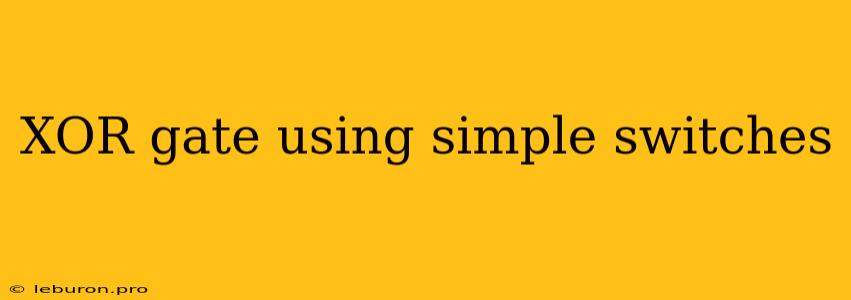The XOR (Exclusive OR) gate is a fundamental logic gate in digital electronics, playing a crucial role in various applications, including data processing, control systems, and cryptography. Understanding the inner workings of an XOR gate is essential for anyone venturing into the realm of digital circuits. While complex integrated circuits (ICs) are commonly used to implement XOR gates, a simple and insightful way to grasp its functionality is by using everyday switches. This article delves into the construction and operation of an XOR gate using simple switches, providing a hands-on approach to understanding this critical logic gate.
The XOR Gate: A Fundamental Building Block
The XOR gate, represented by the symbol ⊕, is a logic gate that outputs a high (1) signal only when its input signals are different. In other words, the output is true if one and only one input is true. If both inputs are true or both inputs are false, the output is false. This unique behavior sets it apart from other logic gates like AND, OR, and NOT, making it a key component in various digital circuits.
Constructing an XOR Gate with Switches
To understand the XOR gate's functionality using switches, let's consider a simple setup with two switches, labeled A and B, and a lamp that serves as our output indicator. The lamp lights up when the circuit is closed, representing a logic high (1) state.
The Logic Behind the Switch Setup
The key to implementing an XOR gate using switches lies in creating a circuit where the lamp lights up only when one switch is on and the other is off. We can achieve this by connecting the switches in a specific way:
-
Series Connection: Connect switch A and switch B in series. This means that the circuit is complete, and the lamp lights up only if both switches A and B are closed.
-
Parallel Connection: Connect the first part of the circuit (from the power source to switch A) in parallel with the second part of the circuit (from switch B to the lamp). This parallel connection ensures that the lamp lights up if either switch A or switch B is closed.
-
Cross-Connection: Connect the terminal of switch A that is connected to the lamp to the terminal of switch B that is connected to the power source. This cross-connection is essential for the XOR logic.
The Output Behavior
With this arrangement, the lamp will light up only when one of the switches is closed and the other is open. Let's analyze the possible states:
- Switch A ON, Switch B OFF: The circuit is complete through switch A and the parallel connection, causing the lamp to light up.
- Switch A OFF, Switch B ON: The circuit is complete through switch B and the parallel connection, causing the lamp to light up.
- Switch A ON, Switch B ON: Both switches are closed, completing the circuit through both paths. However, the cross-connection creates a short circuit, effectively canceling out the flow of current, and the lamp remains off.
- Switch A OFF, Switch B OFF: Both switches are open, preventing any current flow, and the lamp remains off.
This behavior precisely mirrors the logic of an XOR gate, where the output is true (lamp on) only when the inputs are different (one switch on, the other off).
Understanding the Circuit
The key to understanding why this circuit works is recognizing that the cross-connection plays a critical role. When both switches are on, the cross-connection creates a short circuit. This effectively prevents current from flowing to the lamp, resulting in a logic low output. However, when only one switch is on, the circuit is complete, and the current flows to the lamp, resulting in a logic high output.
Advantages of Using Switches
Using simple switches to implement an XOR gate offers several advantages:
- Simplicity: This approach allows for a clear and intuitive understanding of the XOR gate's logic.
- Hands-On Experience: Building a simple circuit using switches provides a practical and tangible way to experience the concepts of logic gates.
- Cost-Effectiveness: Using readily available switches makes this demonstration both affordable and accessible.
Beyond Simple Switches
While using simple switches to demonstrate the XOR gate's function provides valuable insights, it is important to note that real-world applications involve more complex implementations. Integrated circuits (ICs) provide much more efficient and compact solutions for implementing logic gates in modern electronic devices.
Applications of the XOR Gate
The XOR gate, due to its unique logic function, plays a vital role in a wide range of applications, including:
- Data Processing: XOR gates are essential in binary arithmetic operations, particularly for addition and subtraction.
- Control Systems: They are used in implementing control logic for systems like traffic lights, vending machines, and robotics.
- Cryptography: XOR gates are extensively used in cryptography for encryption and decryption processes, ensuring data security.
Conclusion
Using simple switches to build an XOR gate provides a practical and easily understandable approach to grasping the functionality of this essential logic gate. By understanding the interplay of the switch connections, we can visualize the unique logic behind the XOR gate. This basic understanding lays the foundation for exploring more complex digital circuits and applications, where XOR gates play a critical role in enabling modern technology.
